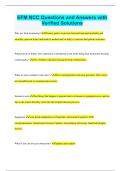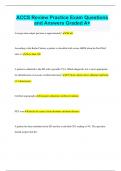Acardemicwriter
Best documents for grade A.
- 45
- 0
- 0
Community
- Followers
- Following
45 items

NCC EFM Questions and Answers Already Graded A
Causes of uteroplacental perfusion decrease: • HTN • Pregnancy • DM • Hypotension • Excessive uterine contractions (hypertonus) • Decreased surface area, edema, degenerative calcifications, infarcts, infection FHR reflects fetal oxygenation from which extrinsic factors: • Maternal oxygenation • Uterine blood flow • Placental change • Umbilical blood flow FHR reflects oxygenation from which intrinsic factors: • Fetal circulation • Oxygenation of tissues •...
- Exam (elaborations)
- • 12 pages •
Causes of uteroplacental perfusion decrease: • HTN • Pregnancy • DM • Hypotension • Excessive uterine contractions (hypertonus) • Decreased surface area, edema, degenerative calcifications, infarcts, infection FHR reflects fetal oxygenation from which extrinsic factors: • Maternal oxygenation • Uterine blood flow • Placental change • Umbilical blood flow FHR reflects oxygenation from which intrinsic factors: • Fetal circulation • Oxygenation of tissues •...

EFM NCC Questions and Answers with Verified Solutions
Why use fetal monitoring? Primary goal is to prevent fetal and maternal morbidity and mortality (prevent injury and death to mother and/ or baby), to prevent bad patient outcomes. What percent of babies who experience a suboptimal event while being fetal monitored, develop cerebral palsy? 3% of babies with poor tracing develop cerebral palsy What are most sentinel events due to? Poor communication between providers. Most errors are traceable back to communication errors. Sentinel eve...
- Exam (elaborations)
- • 19 pages •
Why use fetal monitoring? Primary goal is to prevent fetal and maternal morbidity and mortality (prevent injury and death to mother and/ or baby), to prevent bad patient outcomes. What percent of babies who experience a suboptimal event while being fetal monitored, develop cerebral palsy? 3% of babies with poor tracing develop cerebral palsy What are most sentinel events due to? Poor communication between providers. Most errors are traceable back to communication errors. Sentinel eve...

NCC EFM Cert. Exam (2022/2023) Already Passed
Ductus venosus connects ______ to ______? Umb. vein to IVC Foramen ovale connects _______to______? R. atrium to L. atrium Ductus arteriosus connects _______ to _______? Pulm. artery to aorta Normal rate 110 to 160 BPM Average baseline rate at 15wks gestation 160 BPM Average rate in fetus with heart block 60 BPM (intrinsic ventricular or nodal rate) Sympathetic effects Incr. HR, constricted peripheral and visceral blood vessels, vital organs dilate and receive more blood
- Exam (elaborations)
- • 7 pages •
Ductus venosus connects ______ to ______? Umb. vein to IVC Foramen ovale connects _______to______? R. atrium to L. atrium Ductus arteriosus connects _______ to _______? Pulm. artery to aorta Normal rate 110 to 160 BPM Average baseline rate at 15wks gestation 160 BPM Average rate in fetus with heart block 60 BPM (intrinsic ventricular or nodal rate) Sympathetic effects Incr. HR, constricted peripheral and visceral blood vessels, vital organs dilate and receive more blood

NCC EFM Exam Breakdown & Study Guide (2022/2023) 1
Early deceleration Nadir aligns w contraction peak, gradual onset (≥30 secs to nadir), benign vagal response 1) Pressure on fetal head 2) Increased intracranial pressure 3) Alteration in cerebral blood flow 4) Central vagal stimulation 5) FHR deceleration Periodic vs Episodic Periodic: caused by contractions -recurrent: occurs w ≥50% of contractions in 20 min -intermittent: w <50% of contractions in 20 mins Episodic: spontaneous Variable deceleration Caused by cord compre...
- Exam (elaborations)
- • 29 pages •
Early deceleration Nadir aligns w contraction peak, gradual onset (≥30 secs to nadir), benign vagal response 1) Pressure on fetal head 2) Increased intracranial pressure 3) Alteration in cerebral blood flow 4) Central vagal stimulation 5) FHR deceleration Periodic vs Episodic Periodic: caused by contractions -recurrent: occurs w ≥50% of contractions in 20 min -intermittent: w <50% of contractions in 20 mins Episodic: spontaneous Variable deceleration Caused by cord compre...

NCC EFM Practice Questions and Answers 100% Pass
Which of the following factors can have a negative effect on uterine blood flow? a. Hypertension b. Epidural c. Hemorrhage d. Diabetes e. All of the above e. All of the above Stimulating the vagus nerve typically produces: a. A decrease in the heart rate b. An increase in the heart rate c. An increase in stroke volume d. No change a. A decrease in the heart rate The vagus nerve begins maturation 26 to 28 weeks. Its dominance results in what effect to the FHR baseline? a. I...
- Exam (elaborations)
- • 60 pages •
Which of the following factors can have a negative effect on uterine blood flow? a. Hypertension b. Epidural c. Hemorrhage d. Diabetes e. All of the above e. All of the above Stimulating the vagus nerve typically produces: a. A decrease in the heart rate b. An increase in the heart rate c. An increase in stroke volume d. No change a. A decrease in the heart rate The vagus nerve begins maturation 26 to 28 weeks. Its dominance results in what effect to the FHR baseline? a. I...

NCC EFM QUESTIONS AND ANSWERS 100% PASS
FHR GRADUALLY DECREASES WITH GESTATIONAL AGE DIFFERENCE BETWEEN 30 AND 40 WEEKS IS ABOUT 8-10 bpm BARORECEPTORS *LOCATED IN AORTIC ARCH WALL AND CAROTID WALL *PROTECT FETUS FROM INCREASED IN BP WHEN FETAL BP INCREASES BARORECEPTORS ABRUPTLY DECREASE FHR DECREASE BP DECREASE CO *UMBILICAL CORD COMPRESSION-> *INCREASED FETAL BP-> *STIMULATION OF BARORECEPTORS-> *VARIABLE DECEL ABRUPT RISE IN FETAL BP YOU WILL SEE A VARIABLE DECELERATION FETUS ABILITY TO REGULATE ...
- Exam (elaborations)
- • 2 pages •
FHR GRADUALLY DECREASES WITH GESTATIONAL AGE DIFFERENCE BETWEEN 30 AND 40 WEEKS IS ABOUT 8-10 bpm BARORECEPTORS *LOCATED IN AORTIC ARCH WALL AND CAROTID WALL *PROTECT FETUS FROM INCREASED IN BP WHEN FETAL BP INCREASES BARORECEPTORS ABRUPTLY DECREASE FHR DECREASE BP DECREASE CO *UMBILICAL CORD COMPRESSION-> *INCREASED FETAL BP-> *STIMULATION OF BARORECEPTORS-> *VARIABLE DECEL ABRUPT RISE IN FETAL BP YOU WILL SEE A VARIABLE DECELERATION FETUS ABILITY TO REGULATE ...

NCC EFM QUESTIONS AND ANSWERS 100% PASS
FHR GRADUALLY DECREASES WITH GESTATIONAL AGE DIFFERENCE BETWEEN 30 AND 40 WEEKS IS ABOUT 8-10 bpm BARORECEPTORS *LOCATED IN AORTIC ARCH WALL AND CAROTID WALL *PROTECT FETUS FROM INCREASED IN BP WHEN FETAL BP INCREASES BARORECEPTORS ABRUPTLY DECREASE FHR DECREASE BP DECREASE CO *UMBILICAL CORD COMPRESSION-> *INCREASED FETAL BP-> *STIMULATION OF BARORECEPTORS-> *VARIABLE DECEL ABRUPT RISE IN FETAL BP YOU WILL SEE A VARIABLE DECELERATION FETUS ABILITY TO REGULATE ...
- Exam (elaborations)
- • 51 pages •
FHR GRADUALLY DECREASES WITH GESTATIONAL AGE DIFFERENCE BETWEEN 30 AND 40 WEEKS IS ABOUT 8-10 bpm BARORECEPTORS *LOCATED IN AORTIC ARCH WALL AND CAROTID WALL *PROTECT FETUS FROM INCREASED IN BP WHEN FETAL BP INCREASES BARORECEPTORS ABRUPTLY DECREASE FHR DECREASE BP DECREASE CO *UMBILICAL CORD COMPRESSION-> *INCREASED FETAL BP-> *STIMULATION OF BARORECEPTORS-> *VARIABLE DECEL ABRUPT RISE IN FETAL BP YOU WILL SEE A VARIABLE DECELERATION FETUS ABILITY TO REGULATE ...

ACCS Review Practice Exam Questions and Answers Graded A+
A patient has been intubated in the ED and has a end tidal CO2 reading of 4%. The specialist should suspect that the: A. patient has a pulmonary embolus B. ET tube is in the correct position C. ET tube is in the esophagus D. ET tube is in the right main stem bronchus B. ET tube is in the correct position *etco2 will be > if in the esophagus Post-operatively, Mr. Hart has a 2-3 mm ST segment elevation on his 12 lead electrocardiograph. This is indicative of Myocardial injury W...
- Exam (elaborations)
- • 51 pages •
A patient has been intubated in the ED and has a end tidal CO2 reading of 4%. The specialist should suspect that the: A. patient has a pulmonary embolus B. ET tube is in the correct position C. ET tube is in the esophagus D. ET tube is in the right main stem bronchus B. ET tube is in the correct position *etco2 will be > if in the esophagus Post-operatively, Mr. Hart has a 2-3 mm ST segment elevation on his 12 lead electrocardiograph. This is indicative of Myocardial injury W...

ACCS Questions and Answers Rated A
Which of the 4 critical life function is the first priority Ventilation What assessments world determine how well a patient is ventilating Respiratory Rate Tidal volume Chest movement Breath sounds ETCO2, PaCO2 What assessments world determine how well a patient is oxygenating Heart rate Color Sensorium SaO2, PaO2 What information would help the adult critical care specialist determine if a patient's circulation is adequate Pulse
- Exam (elaborations)
- • 42 pages •
Which of the 4 critical life function is the first priority Ventilation What assessments world determine how well a patient is ventilating Respiratory Rate Tidal volume Chest movement Breath sounds ETCO2, PaCO2 What assessments world determine how well a patient is oxygenating Heart rate Color Sensorium SaO2, PaO2 What information would help the adult critical care specialist determine if a patient's circulation is adequate Pulse

General critical care -ACCS exam (2022/2023) rated A+
What is the thyromental distance? Measurement of the distance between the upper edge of the thyroid cartilage to the chin, while the neck is completely extended. Thyromental distance: what indicates a suspected difficult intubation? Less than 6 cm Thyromental distance: what suggests a non-problematic intubation? 7 cm or greater What type of x-ray should you use to determine proper position of an endotracheal tube? AP x-ray What type of x-ray is helpful in detecting pleural effusion...
- Exam (elaborations)
- • 14 pages •
What is the thyromental distance? Measurement of the distance between the upper edge of the thyroid cartilage to the chin, while the neck is completely extended. Thyromental distance: what indicates a suspected difficult intubation? Less than 6 cm Thyromental distance: what suggests a non-problematic intubation? 7 cm or greater What type of x-ray should you use to determine proper position of an endotracheal tube? AP x-ray What type of x-ray is helpful in detecting pleural effusion...
